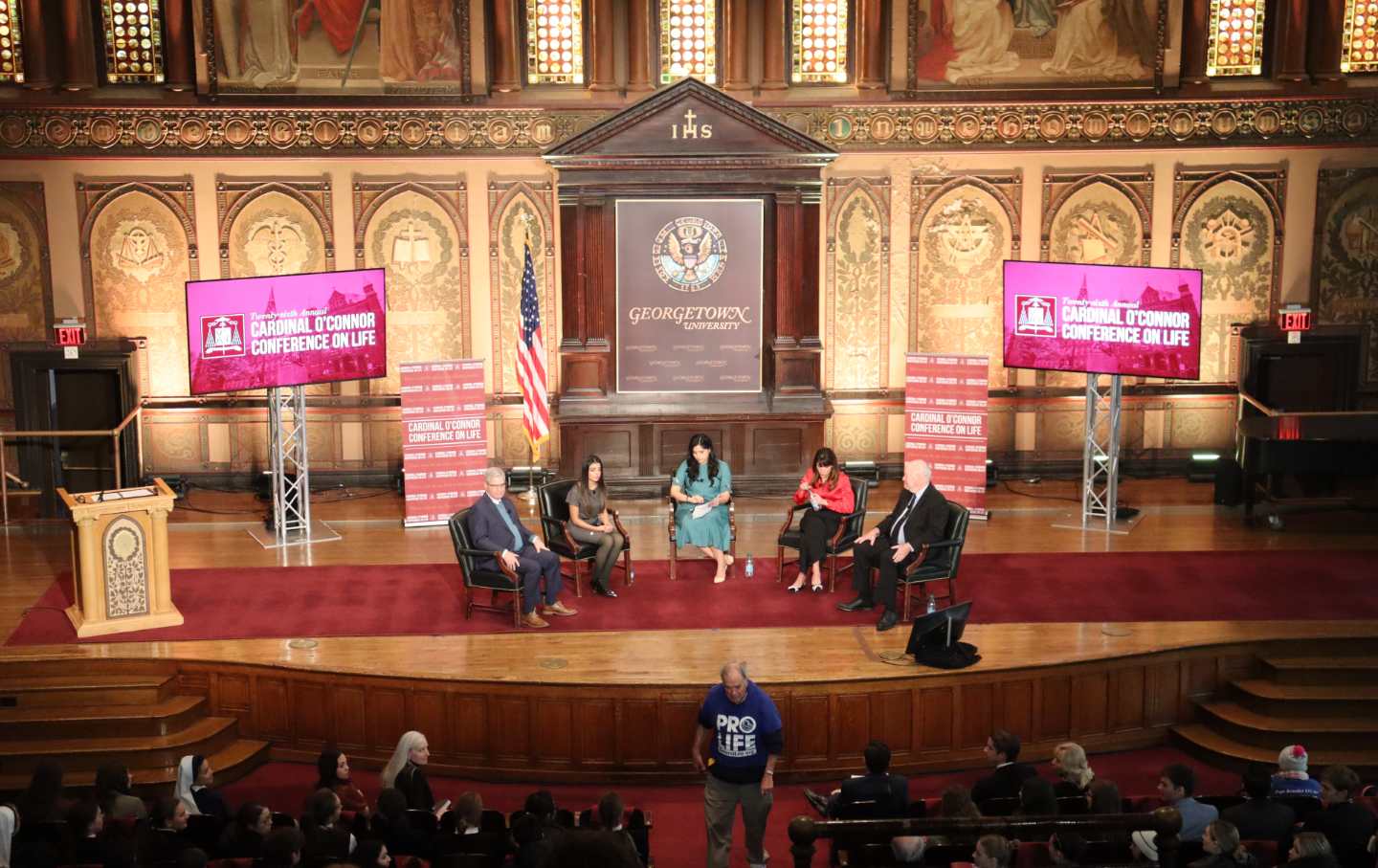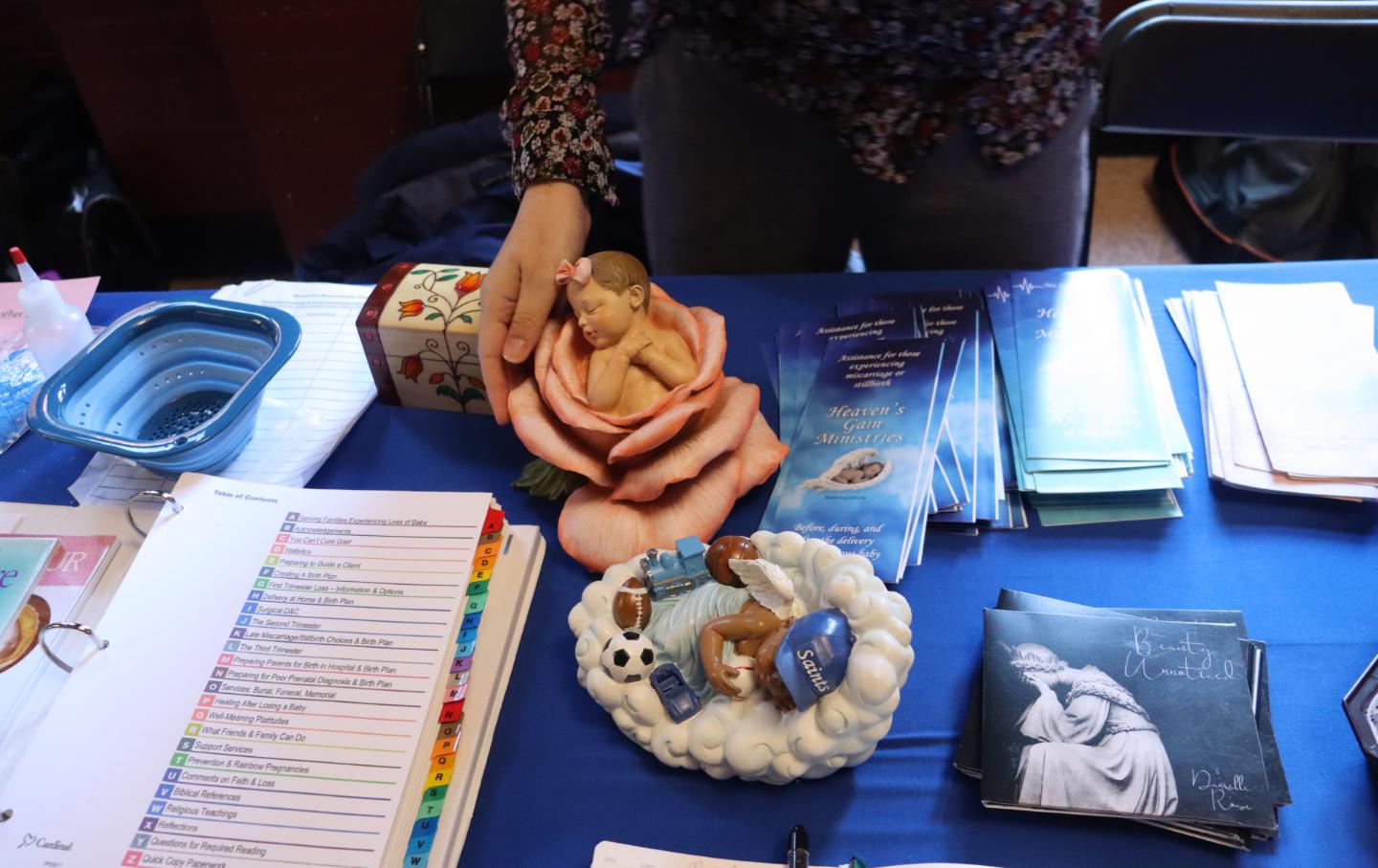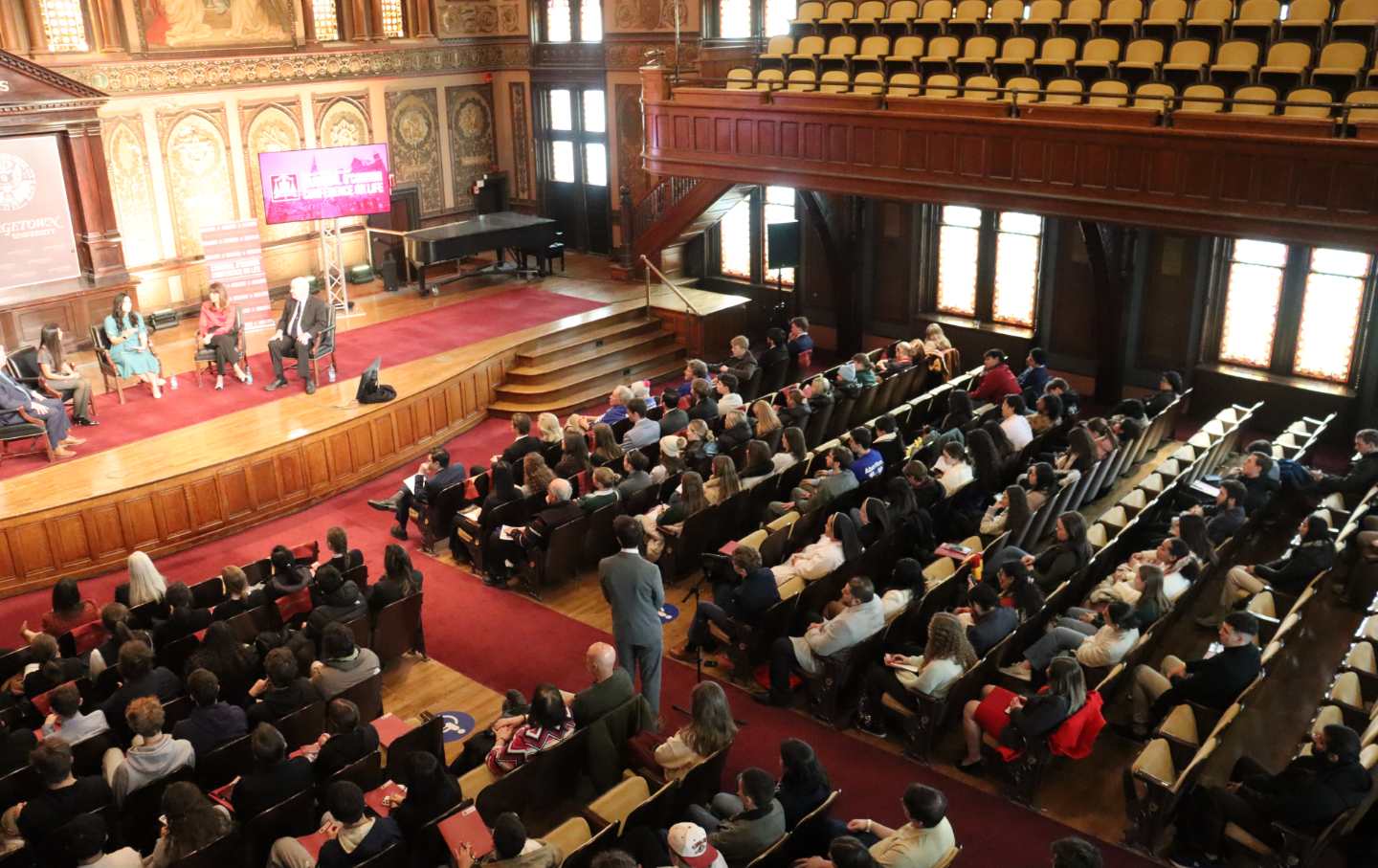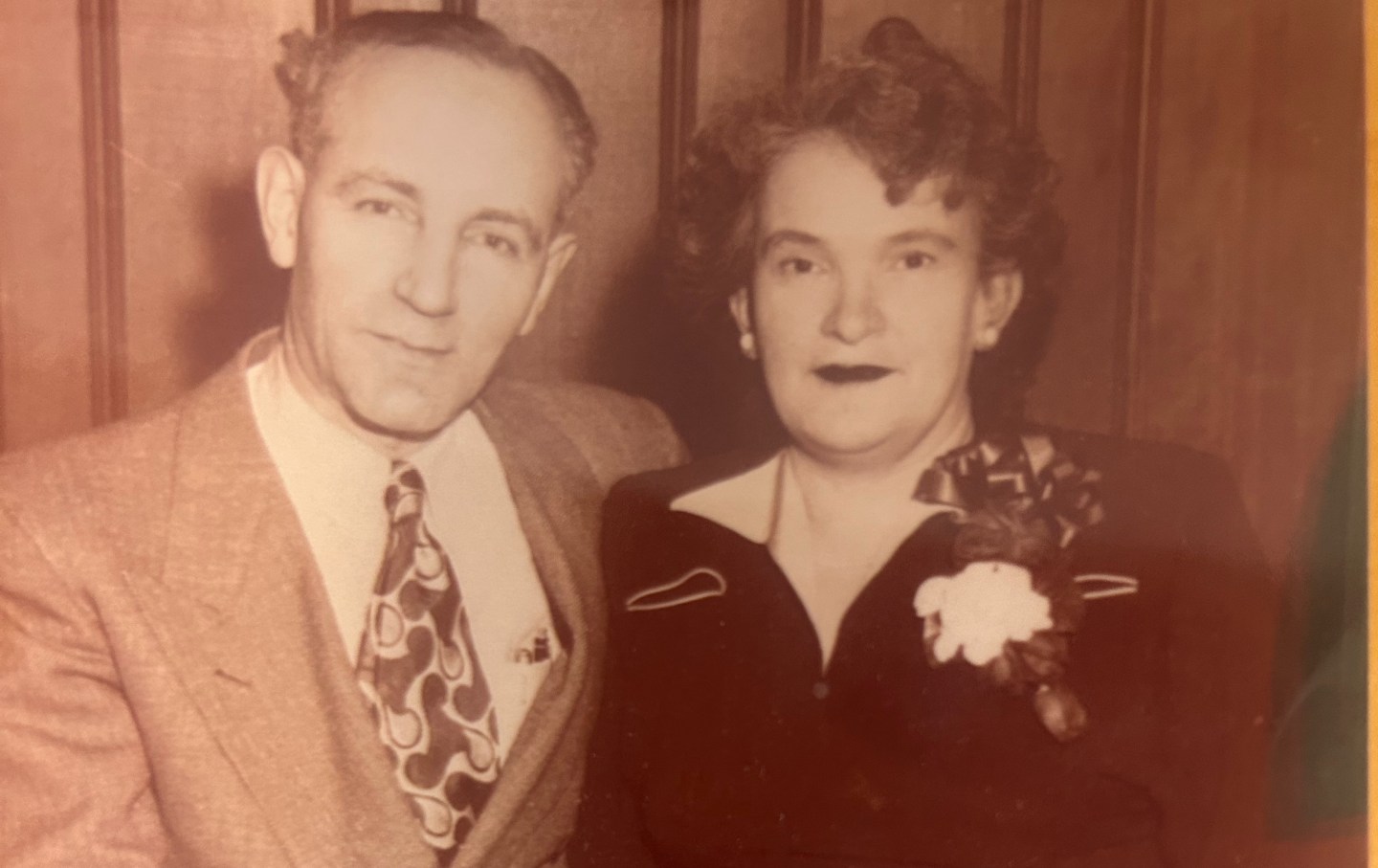Inside Washington, DC’s “Pro-Life Super Bowl”
Days after Donald Trump’s inauguration, hundreds of young anti-abortion activists gathered at Georgetown University for the annual Cardinal O’Connor Conference.

Hundreds of Cardinal O’Connor Conference attendees gather in Georgetown University’s Gaston Hall to hear from anti-abortion activists.
(Katherine Wilkison)
On January 24 and 25, just days after Donald Trump’s inauguration, more than 700 mostly high school– and college-aged anti-abortion activists gathered in Georgetown University’s historic Healy Hall to talk strategy, hear from some of the movement’s biggest names, and “pray for the unborn” at what’s known as the “pro-life Super Bowl.”
While most college students are pro-choice, a vocal few (or on some campuses, a vocal majority) are vehemently anti-abortion. A 2024 Gallup poll found that while 36 percent of 18-to-29-year-olds identify as “pro-life,” only 11 percent of the age group thinks that abortion should be illegal in all cases—including all of the activists who spoke with The Nation.
Since 2000, the conference has brought together hundreds of young anti-abortion activists from across the country who come to DC for the annual March for Life. This year’s event was sponsored by groups like the Jesuit Order, Students for Life, Survivors of the Abortion Holocaust, and CanaVox—an organization devoted to opposing same-sex marriage. The event transforms Gaston Hall into a shrine of pro-life relics, from neonatal coffins to fetal dolls. While their imagery and language varied, they all agreed that abortion, at any stage and for any reason, is wrong.
Rey Guevara serves on the board of Rehumanize International, a secular, nonpartisan nonprofit pro-life organization dedicated to advancing the “consistent life ethic.” “I would say [students] are the strongest part of the pro-life movement. They’re very active, they have a lot of time and energy. We like to get them when they’re young,” he said. Students for Life, for example, America’s largest student-focused anti-abortion organization, has more than 1,500 campus groups, meaning they are present at more than 30 percent of US colleges. The group claims to have trained more than 213,000 advocates since 2006.
Originally coined by Catholics, the consistent life ethic seeks to promote life issues from “womb to tomb” and includes an opposition to abortion and the death penalty. Almost all the discussion, though, focused on abortion and how to rally people—especially young people—against it.
Now, as discussions of waiting times, gestation limits, and exceptions for abortion in the cases of rape and incest dominate the discussion, the orthodoxy of the anti-abortion movement has become somewhat obscured. Zaid Munson, a professor at Lehigh University and a scholar of social movements, has spent nearly two decades researching the anti-abortion movement. “There is a misunderstanding about what the goal of the pro-life movement is,” Munson said. “They want to do everything in their power to end all abortions. All of them. Not at six weeks, not at eight weeks, not only those that are not the result of rape and incest and so forth. All of them. That’s been true for decades.”

One of the sponsors of this year’s March For Life, Survivors of the Abortion Holocaust, has hosted an annual “Survivors Prolife Summer Camp” since 1998, bringing around 50 high school and college students to Washington, DC every year. The program is a bootcamp to “equip youth to effectively fight against abortion in their churches, schools, towns, and across the nation,” according to the group’s website. The participants, most of whom are 15 to 20 years old, are taught how to organize protests, pickets, and blockades. This summer they protested outside of the Department of Justice building to call for the release of those incarcerated under the Freedom of Access to Clinic Entrances Act (FACE). The Clinton-era law was passed in response to the murders and attempted murders of several abortion providers in the 1980s and 1990s—long before any of the protestors were born—and prohibits interference with reproductive health clinics, providers, and patients.
Survivors’ newly-appointed DC Coordinator, Kristin Turner, is just 23-years-old, but says that she has been arrested at least six times. “I’ve kind of lost count,” she said.
Turner and many other activists discussed supporting or participating in “rescues” during which anti-abortion activists enter reproductive health clinics to convince, or coerce, people who are scheduled to have an abortion. Anti-abortion activists call it “non-violent resistance.” Reproductive health practitioners call it dangerous and violating. Rescues were most common before the passage of the FACE Act, though some activists continue to participate in them despite the risks including students and other young people.
In the early 1990s, the group Collegians Activated to Liberate Life made a name for itself by engaging in rescues across the Midwest, particularly targeting college towns. The group, which largely stopped participating in rescues after the passage of the FACE Act, began hosting “alternative spring breaks” and “CALL weekends” at college campuses to train and mobilize anti-abortion students.
Just days before the conference, Trump announced pardons for 23 people who had been sentenced under the FACE Act. He also announced that the Department of Justice would no longer pursue prosecutions under the act and would drop any ongoing investigations. Less than 24 hours after the start of Republicans’ trifecta in the House, Senate, and White House, a representative from Texas reintroduced a bill to repeal the act.
Conference attendees and sponsors celebrated Trump’s decision, including Rehumanize International, whose former Executive Director, Herb Geraghty, was pardoned by the president. Geraghty, a 29-year-old activist based in Pittsburgh, had been sentenced to 27 months in prison for his role in using “force and physical obstruction” to blockade the Washington Surgi-Clinic in DC. To Geraghty, the FACE Act “hyper criminalizes purely free speech activities, or purely speech-based activities, like protests, like being in a particular place that someone doesn’t want you to be.”

Since the Supreme Court’s 2022 decision in Dobbs v. Jackson Women’s Health Organization, which overturned Roe v. Wade, there has been a sharp increase in anti-abortion violence. According to the National Abortion Federation, incidents of anti-abortion stalking rose 229 percent, clinic invasions increased by 25 percent, and arson and bioterrorism threats doubled from 2021 to 2022. The repeal of the FACE Act will only lead to further violence, according to Munson. “I think that the sort of abandonment of abortion rights by federal law enforcement will obviously change the incentives for that relatively small piece of the pro-life movement that is willing to break the law in order to achieve their goals and make it more likely that they will, in fact, break laws that protect people surrounding this issue,” Munson said.
Popular
“swipe left below to view more authors”Swipe →When asked if he thinks a possible repeal of the act could lead to violence, Geraghty said, “I think that murder should be illegal, and I think it already is. Well, I think it already is, unless you’re talking about the murder of unborn children.” For now, Geraghty says, rescues are here to stay. “I certainly think there will continue to be rescue, regardless of what that looks like. I would be excited if again, a mass movement of civil disobedience for the pro-life cause was reignited. I can’t predict if that will happen, but that would be cool.”
Of course, some young people are “absolutely” turned off by the anti-abortion movement’s ties to the American right, according to Bella, a Georgetown student and member of the university’s “right to life” organization. “You can fully be against abortion and not be Republican. And there’s plenty of us who are but that doesn’t necessarily stop the associations,” she said. Several people who were pardoned by Trump are affiliated with the Progressive Anti-Abortion Uprising, a group of mostly young, diverse, and progressive anti-abortion activists with an extensive social media presence. With just nine staff members and around 6,600 followers on X, PAAU is small but a frequent source of media attention. In 2022, Lauren Handy, the group’s director of activism and mutual aid, was arrested after police raided her home and found the remains of five fetuses. She was later pardoned alongside Geraghty for her role in the clinic blockade.
While it has not always been the case, for the last 20 years at least, Munson estimates, abortion has been a litmus test for politicians. “It’s no longer possible, and hasn’t been possible for a long time, for someone who is a Republican with national political aspirations to be pro-choice,” said Munson. “For a Democrat with national political aspirations, they have to be pro-choice.”
Despite growing up anti-abortion in a devout Catholic family, Bella was concerned about joining Right to Life after hearing how other students discussed the club. From accusations of homophobia to “shaming” on social media, during her freshman year she was concerned about being publicly identified as a member. Despite being a Catholic school, the majority of Georgetown’s student body is neither Catholic nor anti-abortion.
The power of the pro-life movement was on display once again this month when a Texas midwife, Maria Rojas, and her employee became the first people to be arrested for performing abortions following the state’s adoption of a near-total ban in 2022. In an e-mail to The Nation, a representative from Survivors of the Abortion Holocaust celebrated the arrests. “I’m thrilled to hear about the arrest of Rojas and her employees,” the representative wrote. “Texas is following through on their commitment to treat abortion as a crime and in doing so they are protecting communities most targeted by opportunistic criminals like Rojas.”
Even as some young people in the anti-abortion movement have sought to distance themselves from the Republican Party, Donald Trump’s administration, the right-wing Supreme Court, and the GOP-controlled Congress will undoubtedly aid their cause in the years to come. Despite this institutional support and the movement’s success in completely banning abortion in 13 states, anti-abortion activists still see themselves as social and political targets. “The reality is,” said Turner of Survivors of the Abortion Holocaust, “people hate pro-lifers.”
Disobey authoritarians, support The Nation
Over the past year you’ve read Nation writers like Elie Mystal, Kaveh Akbar, John Nichols, Joan Walsh, Bryce Covert, Dave Zirin, Jeet Heer, Michael T. Klare, Katha Pollitt, Amy Littlefield, Gregg Gonsalves, and Sasha Abramsky take on the Trump family’s corruption, set the record straight about Robert F. Kennedy Jr.’s catastrophic Make America Healthy Again movement, survey the fallout and human cost of the DOGE wrecking ball, anticipate the Supreme Court’s dangerous antidemocratic rulings, and amplify successful tactics of resistance on the streets and in Congress.
We publish these stories because when members of our communities are being abducted, household debt is climbing, and AI data centers are causing water and electricity shortages, we have a duty as journalists to do all we can to inform the public.
In 2026, our aim is to do more than ever before—but we need your support to make that happen.
Through December 31, a generous donor will match all donations up to $75,000. That means that your contribution will be doubled, dollar for dollar. If we hit the full match, we’ll be starting 2026 with $150,000 to invest in the stories that impact real people’s lives—the kinds of stories that billionaire-owned, corporate-backed outlets aren’t covering.
With your support, our team will publish major stories that the president and his allies won’t want you to read. We’ll cover the emerging military-tech industrial complex and matters of war, peace, and surveillance, as well as the affordability crisis, hunger, housing, healthcare, the environment, attacks on reproductive rights, and much more. At the same time, we’ll imagine alternatives to Trumpian rule and uplift efforts to create a better world, here and now.
While your gift has twice the impact, I’m asking you to support The Nation with a donation today. You’ll empower the journalists, editors, and fact-checkers best equipped to hold this authoritarian administration to account.
I hope you won’t miss this moment—donate to The Nation today.
Onward,
Katrina vanden Heuvel
Editor and publisher, The Nation








